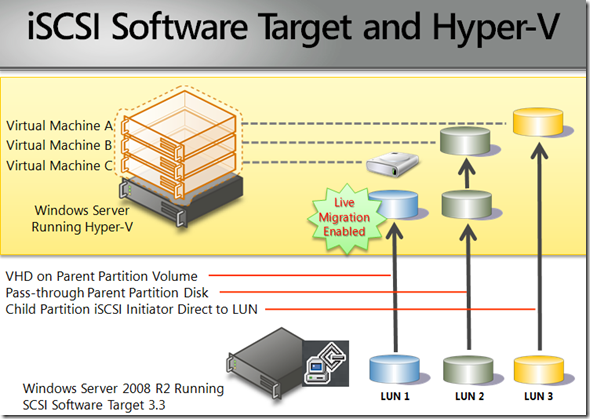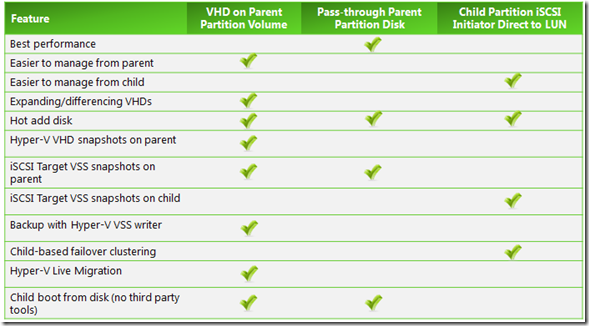iSCSI Software Target 3.3 is now a free download!
Microsoft got into the iSCSI Target business when we acquired WinTarget from String Bean software in 2006. We continued to improve the software over the last 5 years; increasing performance and reliability, adding support for new languages and technologies like IPv6, Windows Server Failover Clustering, Microsoft MPIO, PowerShell cmdlets and even differencing VHDs. We updated the iSCSI Software Target twice a year and released it as an optional add-on for Windows Storage Server editions. These operating systems and a “production-use” iSCSI Software Target were only available through Windows “embedded” OEMs, those that build preconfigured storage appliances.
Until Now! The iSCSI Software Target 3.3 can now be downloaded by anybody and used on regular versions of Windows Server 2008 R2! The new download will install on Windows Server 2008 R2 Standard, Enterprise or Datacenter. Checkout Jose Barreto’s blog that details the download and setup experience for the iSCSI Software Target 3.3.
OEM storage partners have shipped hundreds of thousands of Windows Storage Server appliances and the demand for Network Attached Storage is continuing to grow at a rapid pace. IDC expects the HDD industry to ship more petabytes for enterprise applications in the next two years than it did in the preceding 20 years. iSCSI is a simple and cost effective way to create shared storage due to the use of industry standard hardware and off-the shelve networking gear. IP networking is pretty simple stuff compared to setting up a Fibre Channel SAN.
See my blog from last year outlining six uses for the iSCSI Software Target. You can see how it enables Hyper-V cluster deployments using Live-Migration. During our testing using a decent mid-range array (the popular HP MSA2324sa), we were able to setup a two-node Windows Storage Server 2008 R2 failover cluster and configured 92 individual Hyper-V VMs. Each VM was running a data-intensive application that was simultaneously storing data to the iSCSI Target cluster. The test was an unplanned failure of the primary iSCSI Target node and we verified that we had a successful failover of all 92 VMs! to the second node. The VMs continued to run their data-intensive applications without interruption and there were zero blue-screens that will happen if you hit critical storage resource timeouts. That is pretty impressive and it really shows the scalability of the product.
See this supported and tested limits article for information on how many targets, connections and virtual disks a single Windows storage appliance can handle. The iSCSI Initiator Users Guide for Windows 7 and Windows Server 2008 R2 was posted earlier this month and it contains a wealth of information on how to optimally configure iSCSI connections.
The iSCSI Software Target 3.3 for Windows Server 2008 R2 supports these key features:
Flexible Storage
- Up to 16TB LUNs can be created using the VHD (Virtual Hard Disks) format. These VHDs live on top of NTFS and NTFS supports up to 16TB files.
- Manually extend LUNs if you need more space
- Use VSS to create application consistent snapshots and access those snapshots locally or remotely
- Use an iSCSI HBA or a software bootloader to boot diskless servers off of remote iSCSI Targets. Checkout the iSCSI Boot Step-by-Step Guide for instructions.
Technology Support
- 2008 R2 Failover Clusters
- IPv6
- Differencing VHDs that are especially useful if you want to boot hundreds of diskless HPC Server nodes in a few minutes.
- CHAP Authentication
- Virtual Disk Service (VDS)
- MPIO
- Internet Storage Name Service (iSNS) Integration
- Dynamic Disks are supported from the Initiator
Language Support
Note that the setup experience is only in English, but once you get through setup, the iSCSI Target contains localized version for 10 language packs:
- Brazilian Portuguese
- Chinese – simplified
- Chinese – traditional
- English
- French
- German
- Italian
- Japanese
- Korean
- Russian
- Spanish
Hyper-V Connectivity Options
When you are connecting an iSCSI LUN to a Hyper-V VM you have 3 ways to connect the storage (outlined below). If you need more details, checkout another of Jose’s posts: Step-by-step: Using the Microsoft iSCSI Software Target with Hyper-V (Standalone, Full, VHD) for a walk though detailing how to set it up. If you want to use Live Migration, you will want to setup a clustered Hyper-V host with shared storage and place the VM on the Hyper-V Parent partition.
Hyper-V Connectivity Considerations
There are a few things you should think about before deciding which option to use.
I hope you enjoy this software as much as we do at Microsoft. If you love something, set it free!
Cheers,
Scott Johnson
Program Manager
Windows Storage Server


